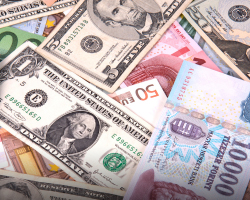Round Numbers in Forex Trading
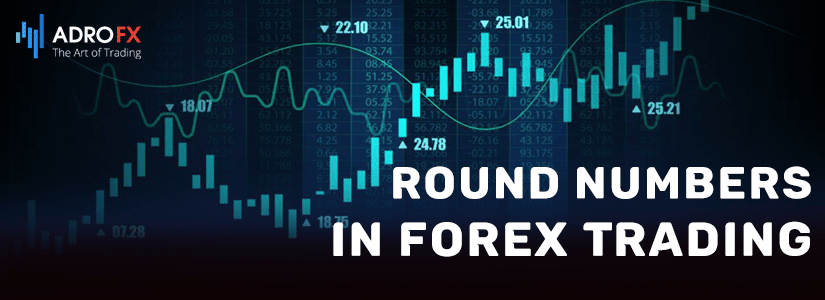
Technical analysis of the market gives a variety of options for predicting the price movement based on the known indicators and their derivatives, resistance and support levels, Fibonacci Retracement, trend lines, etc. But there is one more tool, specific enough, which is seldom mentioned in classical analysis literature, and that is why it arouses great interest among traders. We are talking about the so-called "round levels".
The round levels have a psychological background. In real life, we often deal with round numbers, on the psychology on which many marketing moves are based, and ordinary people are used to round numbers to tens and hundreds.
The situation in the forex market is similar: when the price reaches a round level, traders try to close their positions, believing quite reasonably that at this level, it is very probable that there will be mass closing of positions and opening of opposite orders. If we draw lines through circular levels in a randomly selected area of the market, we will clearly see their significance.

Types of Rounded Levels
The round levels are divided into several types depending on their rounding degree:
parity levels – the strongest levels with the maximum degree of rounding (1.0000, 2.0000, etc.). Such levels can serve as a reference point for trading for many months;
thousandth levels – rounding to tenths (1.1000, 1.2000);
hundredth levels - rounded to hundredths (1.1100, 1.1200) and important for a specific trading session.
How Strategies Work on Round Levels
Some seasoned traders say that round levels act as a magnet for the price, and when you look at the chart it's hard to disagree. The answer to this mystery lies in the area of human psychology.
The fact is that the human brain is used to simplify things, which is why round levels look so attractive for placing Stop Loss and Take Profit orders, it is much more comfortable to set them at a whole level, for example, 1.1500, than to place it at 1.1487. This way the information is easier to remember and more convenient to count.
Often these levels look like a sort of range boundary, especially during an intraday movement with average volatility. For example, the day started with a level close to 1.1300, if the trading system takes into account the round levels, then the 2 nearest strong points are 1.1400 and 1.1200.
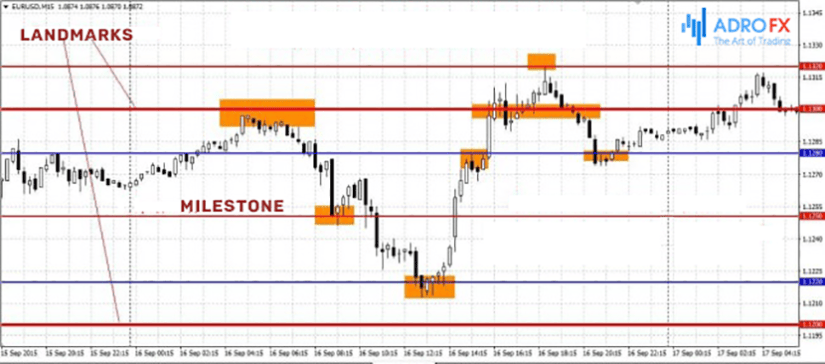
In the morning the price started a smooth decline to about 1.1280, its breakout became a milestone, and the price collapsed to 1.1250. This level can be considered as about the middle of the daily price path, so some sellers closed short positions and formed a small pullback.
In the afternoon the fall continued from the level of 1.1220, at this level the bears decided that the potential of downward movement for today is exhausted (about 80-85% of the potential daily movement was passed). So the stage of fixing sales has gone. However, not all levels work out so well, some of them don't have a significant impact on the price movement.
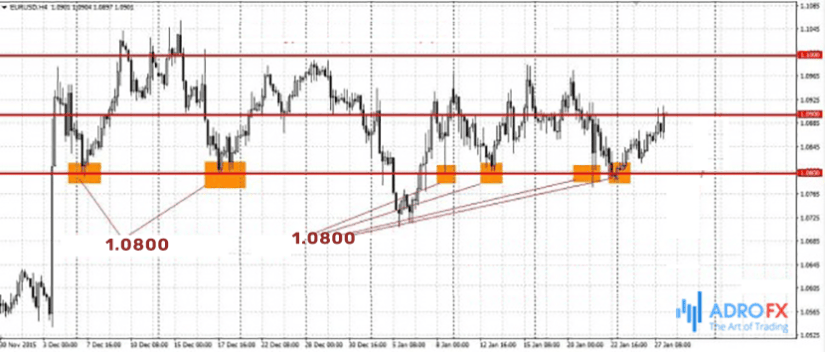
On the same day, the price failed to break out of resistance at 1.1300, eventually falling back to 1.1280. As we can see, throughout the day the round levels were significant for the price, and since the example is shown on M15, levels multiple of 10 were used. In a higher time frame, the same principle holds. Different strategies based on round levels use these regularities in price movement.
Applying Round Levels in Live Trading
You have to understand that ordinary traders who place their orders at round levels have practically no effect on price movement, and their volumes are negligible as compared to market makers. That is why it may happen so often that the price seems not to notice the round levels, so you should not exclusively rely on them in trading.
Also, it is not advisable to place Stop Loss and Take Profit right on the round levels, it is better to count on the fact that the price will not reach it a little. If you planned to place the Take Profit, for instance, at 1.1500, better not to be greedy and put it a little lower at 1.1495-1.1497.
Attempts to enter the market upon breakout of the round level are also risky. First, such a breakout can be false (the price will move in the necessary direction for some time due to the simultaneous triggering of a large number of orders), and second, due to the jump-like movement, requotes are possible.
The round levels should be used in real trading only in combination with other instruments to confirm the obtained signal. Also one should pay attention to the graphical patterns and candlestick combinations. In this case, the presence of the price near the round level will be an additional factor enhancing the signal obtained from the trading strategy.
They should not necessarily be used as a basic tool for finding entry points into the market, they often are given the role of an auxiliary tool. For example, it is logical to place a Stop Loss and Take Profit around them.
Forex Strategies Based on Round Levels
Round levels are significant psychological frontiers for many traders. Therefore, when the price approaches any of these levels, there is an immediate reaction in the form of clusters of different types of orders. Their strength is so great that they may even be an obstacle to a strong news movement. How can this be used in real trading?
They can be used as a supplement to a working strategy. For example, you can refrain from entering a position if you find one of these levels close to the price movement path when you get the signal.
If the signal to enter a position is located near a price level, it can serve as a strong confirmation of its reliability. There are also many quite independent strategies based solely on round levels. Let`s have a look at them.
Double Zero
A scalping strategy using 00 and 50 levels can serve as a more proven version. Trading is done in M5 and M15 time frames with a Stop Loss set at a small distance behind the price level.
When trading the M15 time frame, levels with zeros at the last two digits and EMA with a period of 20 are used. The strategy is multi-currency, giving about 120 points of average monthly profit.
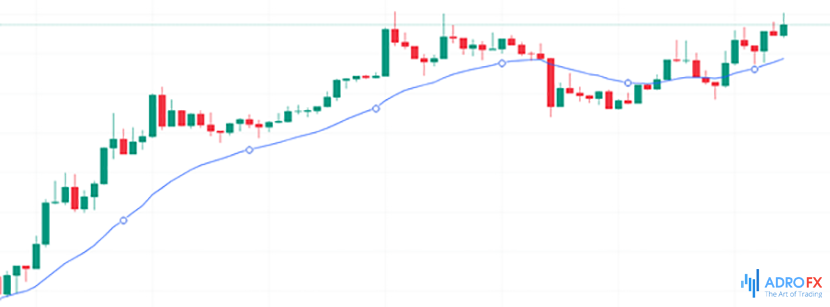
The conditions for placing a short position are as follows:
- The EMA is significantly below the price and is directed upward;
- The price reaches a round level with two zeros, and the next candle should close behind this boundary;
- If the market reverses below the level and the next candle closes below it, at the close of this candle we place a short position. The EMA should still be below the price chart;
- Stop Loss is set equal to 20 points from the moment of market entry, and when the price passes 20 points in the positive direction, is moved to breakeven;
- Profit is fixed after 40 points from the moment the position is entered.
The conditions for placing a long position are limited by the following requirements:
- The EMA is significantly above the price and is directed downward;
- The price reaches a round level with two zeros, and the next candle should close below this boundary;
- If the market beyond the level reverses upwards, and the next candle closes above it, at the close of that candle we place a buy order. The EMA should still be above the price chart;
- Stop Loss is equal to 20 points from the moment of market entry, and when the trade passes 20 points in the positive direction, is moved to breakeven;
- Profit is fixed after 40 points from the moment of entering the position.
Round Levels Trading with Pending Orders
In this case, only the levels with 2 zeros and the mid-levels will be used, the mid-levels are not taken into consideration. The market entry is supposed to be carried out only by pending orders, no indicators are used and the currency pair can be any, but it is undesirable to apply the strategy to highly volatile assets.
The strategy is implemented in the following sequence:
- The price in the morning (even before the opening of the London Stock Exchange) should be near one of the round levels. Ideally, it should stay near it for a long time;
- We backtrack from this level by 25 points up and down and place pending buy and sell orders accordingly;
- Тake Profit is set at 25 points, and Stop Loss is 50 points. The ratio of potential profit and loss is not favorable, but this disadvantage is more than compensated by the fact that there are many times more profitable trades than loss-making ones.

Once one order is triggered, the other is immediately deleted. The open position is not moved to the next day, but the cases when neither Stop Loss nor Take Profit have not triggered during the day are very rare, so the trades are rarely closed manually.
Non-Indicator Round Levels Strategy
This one does not use any indicators, the strategy rules have been developed based solely on the study of accumulated statistics. Here we use the levels that multiple of 100 only, i.e. with 2 zeros.
There are several possible scenarios:
- False breakout - the price breaks out the level and leaves it at a distance of not more than 23 points. As a rule, the accumulation of triggered orders encourages the price to go a little bit beyond the resistance, in this case, we consider the breakout to be false and trade the price's pullback from the resistance;
- We can also trade on the breakout of the level, but in this case, the magnitude of the throw should be at least 25 pips;
- If the price does not reach support/resistance in 5 points, we will also trade on the breakout.
The market entry is supposed to be made only by pending orders. To get the level for pending order placement one should add 20 points to the close price of the signal candle in the direction of the intended trade and place the pending order at this level.
Additional rules of strategy:
- You should not have more than 1 open trade at the same time;
- Stop Loss and Take Profit orders are obligatory. SL equals 40-45 points, and TP - about 70-75 points;
- You can use a standard Trailing Stop, but it`s recommended to manually move the Stop Loss at a distance of 30 points behind the Close price of the last candle;
- Once Stop Loss is triggered, the level at which it happened, will not be taken into account on that day;
- If within 15 hours the trade is closed neither at Take Profit nor at Stop Loss, we close it manually;
- If the pending order does not trigger after the signal candle is formed, it is deleted, and the signals from that level are no longer used.
The disadvantage of this strategy at round levels is a complete lack of market analysis. Still, it would be desirable to add a couple of filters for the obtained signal, at least Moving Averages.
Summary
Round levels strategies are extremely simple trading algorithms. Some of them are even too simple and resemble roulette, but there are also workable systems.
The influence of round levels on price behavior is not questionable, this fact can easily be checked by yourself, just open your terminal and look at the price behavior around them. The main problem is that this pattern is known to all traders, both ordinary traders and market makers. That is why all problems occur when trying to use these levels without additional filters.
Those who want to try trading at round levels may be advised not to base their trading system entirely on them, but to try to integrate them into an already working strategy. It is more logical than guessing whether the price will rebound from or break out of this level.


